Only the First Two Equivalence Points Can Be Observed. What Is the Most Likely Identity of the Acid?
15.6: Acid-Base Titration Curves
- Page ID
- 41626
Learning Objectives
- To calculate the pH at any indicate in an acid–base of operations titration.
In an acid–base titration, a buret is used to deliver measured volumes of an acid or a base solution of known concentration (the titrant) to a flask that contains a solution of a base of operations or an acid, respectively, of unknown concentration (the unknown). If the concentration of the titrant is known, then the concentration of the unknown tin be determined. The following discussion focuses on the pH changes that occur during an acid–base titration. Plotting the pH of the solution in the flask against the amount of acid or base added produces a titration curve. The shape of the curve provides important data almost what is occurring in solution during the titration.
Titrations of Strong Acids and Bases
Effigy \(\PageIndex{1a}\) shows a plot of the pH as 0.20 Thou \(\ce{HCl}\) is gradually added to 50.00 mL of pure water. The pH of the sample in the flask is initially 7.00 (as expected for pure water), but it drops very rapidly every bit \(\ce{HCl}\) is added. Eventually the pH becomes constant at 0.lxx—a point well beyond its value of 1.00 with the addition of l.0 mL of \(\ce{HCl}\) (0.70 is the pH of 0.twenty M HCl). In dissimilarity, when 0.twenty M \(\ce{NaOH}\) is added to 50.00 mL of distilled water, the pH (initially 7.00) climbs very rapidly at kickoff merely then more gradually, eventually budgeted a limit of 13.thirty (the pH of 0.20 G NaOH), once again well beyond its value of 13.00 with the addition of 50.0 mL of \(\ce{NaOH}\) equally shown in Figure \(\PageIndex{1b}\). Every bit y'all can run across from these plots, the titration bend for calculation a base is the mirror paradigm of the curve for adding an acid.
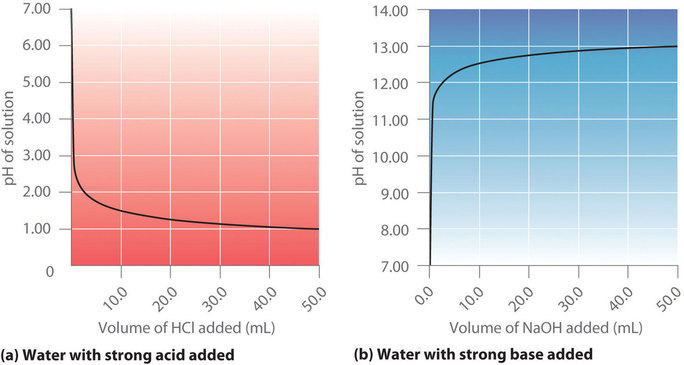
Suppose that we at present add 0.20 Thousand \(\ce{NaOH}\) to 50.0 mL of a 0.ten M solution of \(\ce{HCl}\). Because \(\ce{HCl}\) is a stiff acid that is completely ionized in water, the initial \([H^+]\) is 0.10 M, and the initial pH is one.00. Adding \(\ce{NaOH}\) decreases the concentration of H+ because of the neutralization reaction (Effigy \(\PageIndex{2a}\)):
\[\ce{OH^{−} + H^{+} <=> H_2O}. \nonumber\]
Thus the pH of the solution increases gradually. Most the equivalence signal, however, the betoken at which the number of moles of base (or acid) added equals the number of moles of acid (or base) originally present in the solution, the pH increases much more than speedily because nearly of the \(\ce{H^{+}}\) ions originally present have been consumed. For the titration of a monoprotic strong acid (\(\ce{HCl}\)) with a monobasic strong base (\(\ce{NaOH}\)), nosotros tin can calculate the volume of base of operations needed to reach the equivalence betoken from the following relationship:
\[moles\;of \;base of operations=(volume)_b(molarity)_bV_bM_b= moles \;of \;acid=(volume)_a(molarity)_a=V_aM_a \characterization{Eq1}\]
If 0.20 M \(\ce{NaOH}\) is added to 50.0 mL of a 0.10 Grand solution of \(\ce{HCl}\), we solve for \(V_b\):
\[V_b(0.twenty Me)=0.025 L=25 mL\]
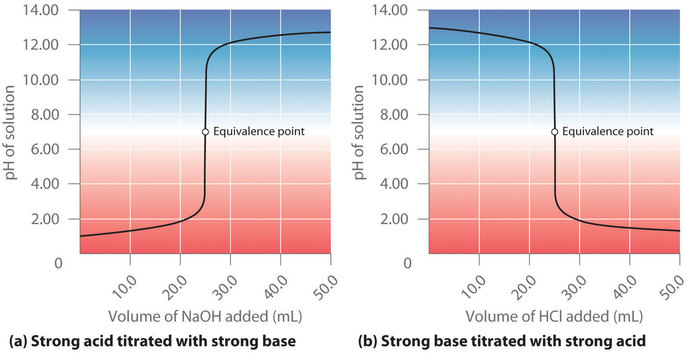
At the equivalence point (when 25.0 mL of \(\ce{NaOH}\) solution has been added), the neutralization is consummate: only a salt remains in solution (NaCl), and the pH of the solution is seven.00. Calculation more than \(\ce{NaOH}\) produces a rapid increment in pH, but eventually the pH levels off at a value of most 13.30, the pH of 0.20 M \(NaOH\).
Equally shown in Figure \(\PageIndex{2b}\), the titration of 50.0 mL of a 0.ten M solution of \(\ce{NaOH}\) with 0.20 M \(\ce{HCl}\) produces a titration curve that is virtually the mirror epitome of the titration curve in Figure \(\PageIndex{2a}\). The pH is initially thirteen.00, and it slowly decreases equally \(\ce{HCl}\) is added. As the equivalence point is approached, the pH drops rapidly before leveling off at a value of most 0.70, the pH of 0.20 M \(\ce{HCl}\).
The titration of either a strong acrid with a stiff base or a strong base with a stiff acid produces an S-shaped bend. The curve is somewhat asymmetrical because the steady increase in the book of the solution during the titration causes the solution to become more dilute. Due to the leveling effect, the shape of the curve for a titration involving a strong acid and a potent base depends on only the concentrations of the acrid and base of operations, not their identities.
The shape of the titration curve involving a strong acid and a strong base depends merely on their concentrations, not their identities.
Example \(\PageIndex{one}\): Hydrochloric Acid
Calculate the pH of the solution after 24.xc mL of 0.200 M \(\ce{NaOH}\) has been added to fifty.00 mL of 0.100 M \(\ce{HCl}\).
Given: volumes and concentrations of stiff base and acid
Asked for: pH
Strategy:
- Calculate the number of millimoles of \(\ce{H^{+}}\) and \(\ce{OH^{-}}\) to determine which, if either, is in excess after the neutralization reaction has occurred. If 1 species is in backlog, calculate the corporeality that remains after the neutralization reaction.
- Determine the concluding volume of the solution. Summate the concentration of the species in excess and convert this value to pH.
Solution
A Considering 0.100 mol/L is equivalent to 0.100 mmol/mL, the number of millimoles of \(\ce{H^{+}}\) in 50.00 mL of 0.100 Chiliad \(\ce{HCl}\) can be calculated as follows:
\[ 50.00 \cancel{mL} \left ( \dfrac{0.100 \;mmol \;HCl}{\abolish{mL}} \right )= v.00 \;mmol \;HCl=5.00 \;mmol \;H^{+} \nonumber\]
The number of millimoles of \(\ce{NaOH}\) added is as follows:
\[ 24.90 \cancel{mL} \left ( \dfrac{0.200 \;mmol \;NaOH}{\cancel{mL}} \right )= 4.98 \;mmol \;NaOH=4.98 \;mmol \;OH^{-} \nonumber\]
Thus \(\ce{H^{+}}\) is in excess. To completely neutralize the acid requires the improver of 5.00 mmol of \(\ce{OH^{-}}\) to the \(\ce{HCl}\) solution. Because only 4.98 mmol of \(OH^-\) has been added, the amount of excess \(\ce{H^{+}}\) is five.00 mmol − 4.98 mmol = 0.02 mmol of \(H^+\).
B The final volume of the solution is 50.00 mL + 24.90 mL = 74.90 mL, and so the final concentration of \(\ce{H^{+}}\) is equally follows:
\[ \left [ H^{+} \right ]= \dfrac{0.02 \;mmol \;H^{+}}{74.xc \; mL}=iii \times 10^{-4} \; K \nonumber\]
Hence,
\[pH \approx −\log[\ce{H^{+}}] = −\log(3 \times 10^{-4}) = three.five \nonumber\]
This is significantly less than the pH of vii.00 for a neutral solution.
Exercise \(\PageIndex{ane}\)
Calculate the pH of a solution prepared by adding \(twoscore.00\; mL\) of \(0.237\; M\) \(HCl\) to \(75.00\; mL\) of a \(0.133 Thousand\) solution of \(NaOH\).
- Respond
-
xi.half dozen
Titrations of Weak Acids and Bases
In contrast to strong acids and bases, the shape of the titration curve for a weak acid or a weak base depends dramatically on the identity of the acrid or the base and the corresponding \(K_a\) or \(K_b\). As we shall see, the pH besides changes much more than gradually around the equivalence betoken in the titration of a weak acrid or a weak base. As you learned previously, \([\ce{H^{+}}]\) of a solution of a weak acid (HA) is not equal to the concentration of the acid merely depends on both its \(pK_a\) and its concentration. Because only a fraction of a weak acid dissociates, \([\(\ce{H^{+}}]\) is less than \([\ce{HA}]\). Thus the pH of a solution of a weak acid is greater than the pH of a solution of a strong acid of the same concentration.
Figure \(\PageIndex{3a}\) shows the titration curve for 50.0 mL of a 0.100 Chiliad solution of acerb acrid with 0.200 M \(\ce{NaOH}\) superimposed on the curve for the titration of 0.100 Thou \(\ce{HCl}\) shown in part (a) in Effigy \(\PageIndex{2}\). Below the equivalence betoken, the two curves are very different. Earlier any base of operations is added, the pH of the acerb acid solution is greater than the pH of the \(\ce{HCl}\) solution, and the pH changes more rapidly during the first part of the titration. Note too that the pH of the acerb acid solution at the equivalence indicate is greater than vii.00. That is, at the equivalence point, the solution is basic. In add-on, the change in pH around the equivalence point is only well-nigh half every bit large as for the \(\ce{HCl}\) titration; the magnitude of the pH change at the equivalence betoken depends on the \(pK_a\) of the acid beingness titrated. To a higher place the equivalence point, notwithstanding, the ii curves are identical. Once the acid has been neutralized, the pH of the solution is controlled but by the amount of excess \(\ce{NaOH}\) nowadays, regardless of whether the acid is weak or strong.
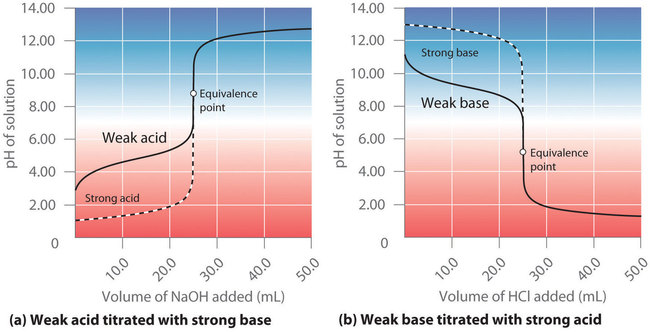
The shape of the titration bend of a weak acid or weak base depends heavily on their identities and the \(K_a\) or \(K_b\).
The titration curve in Figure \(\PageIndex{3a}\) was created past calculating the starting pH of the acerb acid solution before any \(\ce{NaOH}\) is added and and so calculating the pH of the solution after adding increasing volumes of \(NaOH\). The procedure is illustrated in the following subsection and Example \(\PageIndex{2}\) for 3 points on the titration curve, using the \(pK_a\) of acerb acid (four.76 at 25°C; \(K_a = 1.7 \times 10^{-5}\).
Calculating the pH of a Solution of a Weak Acid or a Weak Base
As explained discussed, if nosotros know \(K_a\) or \(K_b\) and the initial concentration of a weak acrid or a weak base of operations, we can calculate the pH of a solution of a weak acid or a weak base of operations by setting up a ICE tabular array (i.e, initial concentrations, changes in concentrations, and final concentrations). In this situation, the initial concentration of acetic acrid is 0.100 M. If we define \(x\) as \([\ce{H^{+}}]\) due to the dissociation of the acid, then the tabular array of concentrations for the ionization of 0.100 M acerb acid is equally follows:
\[\ce{CH3CO2H(aq) <=> H^{+}(aq) + CH3CO2^{−}} \nonumber\]
| ICE | \([CH_3CO_2H]\) | \([H^+]\) | \([CH_3CO_2^−]\) |
|---|---|---|---|
| initial | 0.100 | \(1.00 \times 10^{−7}\) | 0 |
| change | −10 | +x | +x |
| last | 0.100 − x | ten | ten |
In this and all subsequent examples, nosotros will ignore \([H^+]\) and \([OH^-]\) due to the autoionization of water when calculating the last concentration. However, y'all should use Equation 16.45 and Equation 16.46 to check that this assumption is justified.
Inserting the expressions for the terminal concentrations into the equilibrium equation (and using approximations),
\[ \begin{align*} K_a &=\dfrac{[H^+][CH_3CO_2^-]}{[CH_3CO_2H]} \\[4pt] &=\dfrac{(10)(x)}{0.100 - 10} \\[4pt] &\approx \dfrac{x^two}{0.100} \\[4pt] &\approx 1.74 \times x^{-5} \stop{marshal*}\]
Solving this equation gives \(x = [H^+] = 1.32 \times x^{-iii}\; Yard\). Thus the pH of a 0.100 M solution of acetic acid is as follows:
\[pH = −\log(1.32 \times 10^{-3}) = 2.879\]
pH at the Start of a Weak Acid/Strong Base Titration: https://youtu.exist/AtdBKfrfJNg
Calculating the pH during the Titration of a Weak Acid or a Weak Base
Now consider what happens when we add together 5.00 mL of 0.200 M \(\ce{NaOH}\) to l.00 mL of 0.100 M \(CH_3CO_2H\) (function (a) in Figure \(\PageIndex{3}\)). Considering the neutralization reaction proceeds to completion, all of the \(OH^-\) ions added volition react with the acetic acid to generate acetate ion and water:
\[ CH_3CO_2H_{(aq)} + OH^-_{(aq)} \rightarrow CH_3CO^-_{two\;(aq)} + H_2O_{(l)} \label{Eq2}\]
All problems of this blazon must exist solved in two steps: a stoichiometric adding followed by an equilibrium calculation. In the start pace, we use the stoichiometry of the neutralization reaction to summate the amounts of acid and cohabit base nowadays in solution afterwards the neutralization reaction has occurred. In the second stride, we use the equilibrium equation to determine \([\ce{H^{+}}]\) of the resulting solution.
Pace 1
To determine the corporeality of acid and cohabit base in solution afterwards the neutralization reaction, we calculate the amount of \(\ce{CH_3CO_2H}\) in the original solution and the amount of \(\ce{OH^{-}}\) in the \(\ce{NaOH}\) solution that was added. The acerb acrid solution contained
\[ 50.00 \; \abolish{mL} (0.100 \;mmol (\ce{CH_3CO_2H})/\cancel{mL} )=five.00\; mmol (\ce{CH_3CO_2H}) \]
The \(\ce{NaOH}\) solution contained
5.00 mL=i.00 mmol \(NaOH\)
Comparing the amounts shows that \(CH_3CO_2H\) is in backlog. Considering \(OH^-\) reacts with \(CH_3CO_2H\) in a ane:1 stoichiometry, the amount of excess \(CH_3CO_2H\) is as follows:
5.00 mmol \(CH_3CO_2H\) − i.00 mmol \(OH^-\) = 4.00 mmol \(CH_3CO_2H\)
Each i mmol of \(OH^-\) reacts to produce 1 mmol of acetate ion, then the terminal amount of \(CH_3CO_2^−\) is i.00 mmol.
The stoichiometry of the reaction is summarized in the following Ice tabular array, which shows the numbers of moles of the various species, non their concentrations.
\[\ce{CH3CO2H(aq) + OH^{−} (aq) <=> CH3CO2^{-}(aq) + H2o(50)} \nonumber\]
| ICE | \([\ce{CH_3CO_2H}]\) | \([\ce{OH^{−}}]\) | \([\ce{CH_3CO_2^{−}}]\) |
|---|---|---|---|
| initial | v.00 mmol | i.00 mmol | 0 mmol |
| change | −1.00 mmol | −1.00 mmol | +1.00 mmol |
| final | four.00 mmol | 0 mmol | i.00 mmol |
This ICE table gives the initial amount of acetate and the terminal amount of \(OH^-\) ions as 0. Considering an aqueous solution of acerb acid ever contains at to the lowest degree a small amount of acetate ion in equilibrium with acetic acid, nonetheless, the initial acetate concentration is not actually 0. The value can exist ignored in this calculation because the amount of \(CH_3CO_2^−\) in equilibrium is insignificant compared to the amount of \(OH^-\) added. Moreover, due to the autoionization of water, no aqueous solution can contain 0 mmol of \(OH^-\), but the amount of \(OH^-\) due to the autoionization of water is insignificant compared to the amount of \(OH^-\) added. Nosotros apply the initial amounts of the reactants to make up one's mind the stoichiometry of the reaction and defer a consideration of the equilibrium until the second half of the trouble.
Footstep 2
To calculate \([\ce{H^{+}}]\) at equilibrium following the addition of \(NaOH\), we must first summate [\(\ce{CH_3CO_2H}\)] and \([\ce{CH3CO2^{−}}]\) using the number of millimoles of each and the total volume of the solution at this point in the titration:
\[ final \;book=fifty.00 \;mL+5.00 \;mL=55.00 \;mL \] \[ \left [ CH_{iii}CO_{two}H \right ] = \dfrac{4.00 \; mmol \; CH_{three}CO_{2}H }{55.00 \; mL} =7.27 \times x^{-2} \;M \] \[ \left [ CH_{3}CO_{2}^{-} \right ] = \dfrac{1.00 \; mmol \; CH_{3}CO_{2}^{-} }{55.00 \; mL} =1.82 \times ten^{-2} \;M \nonumber\]
Knowing the concentrations of acetic acrid and acetate ion at equilibrium and \(K_a\) for acerb acid (\(1.74 \times ten^{-5}\)), we can calculate \([H^+]\) at equilibrium:
\[ K_{a}=\dfrac{\left [ CH_{3}CO_{2}^{-} \correct ]\left [ H^{+} \correct ]}{\left [ CH_{3}CO_{two}H \right ]} \nonumber\]
\[ \left [ H^{+} \right ]=\dfrac{K_{a}\left [ CH_{three}CO_{2}H \right ]}{\left [ CH_{3}CO_{two}^{-} \right ]} = \dfrac{\left ( 1.72 \times 10^{-five} \right )\left ( 7.27 \times 10^{-two} \;M\right )}{\left ( one.82 \times 10^{-2} \correct )}= six.95 \times 10^{-5} \;Chiliad \]
Calculating \(−\log[\ce{H^{+}}]\) gives
\[pH = −\log(6.95 \times 10^{−v}) = 4.158. \nonumber\]
Comparing the titration curves for \(\ce{HCl}\) and acetic acid in Effigy \(\PageIndex{3a}\), we see that adding the aforementioned amount (5.00 mL) of 0.200 Thou \(\ce{NaOH}\) to fifty mL of a 0.100 M solution of both acids causes a much smaller pH change for \(\ce{HCl}\) (from 1.00 to 1.14) than for acetic acid (2.88 to iv.16). This is consistent with the qualitative description of the shapes of the titration curves at the beginning of this section. In Instance \(\PageIndex{two}\), we calculate another point for amalgam the titration curve of acerb acrid.
pH Before the Equivalence Point of a Weak Acid/Strong Base Titration:
https://youtu.exist/znpwGCsefXc
Example \(\PageIndex{ii}\)
What is the pH of the solution later on 25.00 mL of 0.200 1000 \(\ce{NaOH}\) is added to 50.00 mL of 0.100 M acetic acrid?
Given: volume and molarity of base and acid
Asked for: pH
Strategy:
- Write the balanced chemic equation for the reaction. So calculate the initial numbers of millimoles of \(OH^-\) and \(CH_3CO_2H\). Determine which species, if either, is present in excess.
- Tabulate the results showing initial numbers, changes, and final numbers of millimoles.
- If excess acetate is present later on the reaction with \(\ce{OH^{-}}\), write the equation for the reaction of acetate with water. Use a tabular format to obtain the concentrations of all the species present.
- Calculate \(K_b\) using the human relationship \(K_w = K_aK_b\). Calculate [OH−] and use this to calculate the pH of the solution.
Solution
A Ignoring the spectator ion (\(Na^+\)), the equation for this reaction is as follows:
\[CH_3CO_2H_{ (aq)} + OH^-(aq) \rightarrow CH_3CO_2^-(aq) + H_2O(l) \nonumber\]
The initial numbers of millimoles of \(OH^-\) and \(CH_3CO_2H\) are as follows:
25.00 mL(0.200 mmol OH−mL=v.00 mmol \(OH-\)
\[50.00\; mL (0.100 CH_3CO_2 HL=five.00 mmol \; CH_3CO_2H \nonumber\]
The number of millimoles of \(OH^-\) equals the number of millimoles of \(CH_3CO_2H\), so neither species is present in excess.
B Because the number of millimoles of \(OH^-\) added corresponds to the number of millimoles of acetic acrid in solution, this is the equivalence point. The results of the neutralization reaction can exist summarized in tabular form.
\[CH_3CO_2H_{(aq)}+OH^-_{(aq)} \rightleftharpoons CH_3CO_2^{-}(aq)+H_2O(l) \nonumber\]
| Ice | \([\ce{CH3CO2H}]\) | \([\ce{OH^{−}}]\) | \([\ce{CH3CO2^{−}}]\) |
|---|---|---|---|
| initial | 5.00 mmol | five.00 mmol | 0 mmol |
| modify | −five.00 mmol | −5.00 mmol | +five.00 mmol |
| final | 0 mmol | 0 mmol | v.00 mmol |
C Considering the production of the neutralization reaction is a weak base, nosotros must consider the reaction of the weak base with water to calculate [H+] at equilibrium and thus the terminal pH of the solution. The initial concentration of acetate is obtained from the neutralization reaction:
\[ [\ce{CH_3CO_2}]=\dfrac{5.00 \;mmol \; CH_3CO_2^{-}}{(50.00+25.00) \; mL}=6.67\times ten^{-2} \; Chiliad \nonumber\]
The equilibrium reaction of acetate with h2o is as follows:
\[\ce{CH_3CO^{-}ii(aq) + H2O(fifty) <=> CH3CO2H(aq) + OH^{-} (aq)} \nonumber\]
The equilibrium abiding for this reaction is
\[K_b = \dfrac{K_w}{K_a} \characterization{16.xviii}\]
where \(K_a\) is the acid ionization constant of acerb acid. We therefore define x as \([\ce{OH^{−}}]\) produced past the reaction of acetate with water. Here is the completed table of concentrations:
\[H_2O_{(l)}+CH_3CO^−_{2(aq)} \rightleftharpoons CH_3CO_2H_{(aq)} +OH^−_{(aq)} \nonumber\]
| \([\ce{CH3CO2^{−}}]\) | \([\ce{CH3CO2H}]\) | \([\ce{OH^{−}}]\) | |
|---|---|---|---|
| initial | 0.0667 | 0 | one.00 × x−7 |
| change | −10 | +x | +ten |
| final | (0.0667 − x) | x | ten |
D We tin obtain \(K_b\) by substituting the known values into Equation \ref{16.eighteen}:
\[ K_{b}= \dfrac{K_w}{K_a} =\dfrac{1.01 \times 10^{-xiv}}{1.74 \times x^{-five}} = 5.eighty \times 10^{-10} \label{16.23}\]
Substituting the expressions for the final values from the ICE table into Equation \ref{16.23} and solving for \(ten\):
\[ \begin{align*} \dfrac{x^{2}}{0.0667} &= 5.80 \times 10^{-10} \\[4pt] ten &= \sqrt{(5.80 \times 10^{-10})(0.0667)} \\[4pt] &= half dozen.22 \times 10^{-6}\end{align*}\]
Thus \([OH^{−}] = half-dozen.22 \times 10^{−6}\, 1000\) and the pH of the final solution is viii.794 (Figure \(\PageIndex{3a}\)). As expected for the titration of a weak acid, the pH at the equivalence point is greater than 7.00 because the product of the titration is a base of operations, the acetate ion, which so reacts with water to produce \(\ce{OH^{-}}\).
Exercise \(\PageIndex{2}\)
Summate the pH of a solution prepared past calculation 45.0 mL of a 0.213 Thousand \(\ce{HCl}\) solution to 125.0 mL of a 0.150 M solution of ammonia. The \(pK_b\) of ammonia is four.75 at 25°C.
- Answer
-
9.23
As shown in part (b) in Figure \(\PageIndex{3}\), the titration curve for NH3, a weak base, is the reverse of the titration bend for acetic acrid. In particular, the pH at the equivalence point in the titration of a weak base is less than seven.00 because the titration produces an acid.
The identity of the weak acid or weak base of operations being titrated strongly affects the shape of the titration curve. Figure \(\PageIndex{4}\) illustrates the shape of titration curves as a function of the \(pK_a\) or the \(pK_b\). Every bit the acid or the base being titrated becomes weaker (its \(pK_a\) or \(pK_b\) becomes larger), the pH alter around the equivalence bespeak decreases significantly. With very dilute solutions, the curve becomes and so shallow that it can no longer be used to make up one's mind the equivalence point.
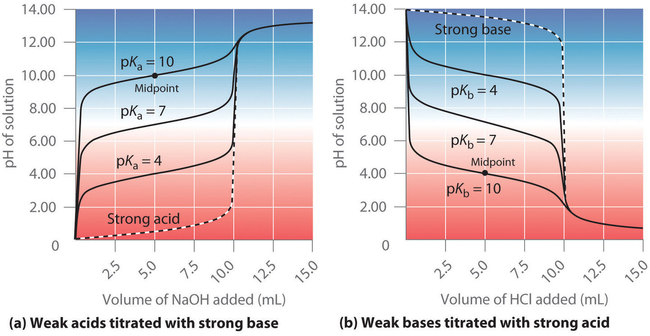
One betoken in the titration of a weak acrid or a weak base of operations is particularly important: the midpoint of a titration is divers as the point at which exactly enough acid (or base of operations) has been added to neutralize half of the acid (or the base) originally present and occurs halfway to the equivalence point. The midpoint is indicated in Figures \(\PageIndex{4a}\) and \(\PageIndex{4b}\) for the 2 shallowest curves. By definition, at the midpoint of the titration of an acid, [HA] = [A−]. Recall that the ionization constant for a weak acid is as follows:
\[K_a=\dfrac{[H_3O^+][A^−]}{[HA]} \nonumber\]
If \([HA] = [A^−]\), this reduces to \(K_a = [H_3O^+]\). Taking the negative logarithm of both sides,
\[−\log K_a = −\log[H_3O+] \nonumber\]
From the definitions of \(pK_a\) and pH, nosotros meet that this is identical to
\[pK_a = pH \characterization{xvi.52}\]
Thus the pH at the midpoint of the titration of a weak acid is equal to the \(pK_a\) of the weak acid, as indicated in function (a) in Figure \(\PageIndex{4}\) for the weakest acid where we see that the midpoint for \(pK_a\) = 10 occurs at pH = 10. Titration methods can therefore be used to decide both the concentration and the \(pK_a\) (or the \(pK_b\)) of a weak acrid (or a weak base).
The pH at the midpoint of the titration of a weak acid is equal to the \(pK_a\) of the weak acid.
Titrations of Polyprotic Acids or Bases
When a stiff base is added to a solution of a polyprotic acrid, the neutralization reaction occurs in stages. The most acidic group is titrated beginning, followed by the adjacent most acidic, and so forth. If the \(pK_a\) values are separated by at least 3 \(pK_a\) units, then the overall titration bend shows well-resolved "steps" corresponding to the titration of each proton. A titration of the triprotic acid \(H_3PO_4\) with \(\ce{NaOH}\) is illustrated in Effigy \(\PageIndex{5}\) and shows two well-defined steps: the get-go midpoint corresponds to \(pK_a\)1, and the 2d midpoint corresponds to \(pK_a\)2. Because HPO4 2 − is such a weak acid, \(pK_a\)3 has such a high value that the 3rd footstep cannot exist resolved using 0.100 M \(\ce{NaOH}\) equally the titrant.

The titration bend for the reaction of a polyprotic base with a strong acid is the mirror epitome of the curve shown in Figure \(\PageIndex{5}\). The initial pH is loftier, but as acid is added, the pH decreases in steps if the successive \(pK_b\) values are well separated. Tabular array E1 lists the ionization constants and \(pK_a\) values for some mutual polyprotic acids and bases.
Example \(\PageIndex{3}\)
Calculate the pH of a solution prepared past adding 55.0 mL of a 0.120 Yard \(\ce{NaOH}\) solution to 100.0 mL of a 0.0510 1000 solution of oxalic acid (\(\ce{HO_2CCO_2H}\)), a diprotic acid (abbreviated every bit \(\ce{H2ox}\)). Oxalic acid, the simplest dicarboxylic acid, is found in rhubarb and many other plants. Rhubarb leaves are toxic because they contain the calcium salt of the fully deprotonated form of oxalic acid, the oxalate ion (\(\ce{O2CCO2^{ii−}}\), abbreviated \(\ce{ox^{2-}}\)).Oxalate salts are toxic for two reasons. Commencement, oxalate salts of divalent cations such as \(\ce{Ca^{2+}}\) are insoluble at neutral pH just soluble at low pH. As a effect, calcium oxalate dissolves in the dilute acid of the breadbasket, assuasive oxalate to be absorbed and transported into cells, where it can react with calcium to form tiny calcium oxalate crystals that damage tissues. Second, oxalate forms stable complexes with metal ions, which can alter the distribution of metallic ions in biological fluids.
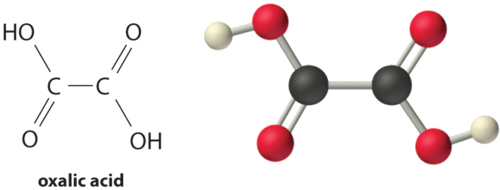
Given: volume and concentration of acid and base
Asked for: pH
Strategy:
- Calculate the initial millimoles of the acid and the base. Use a tabular format to determine the amounts of all the species in solution.
- Calculate the concentrations of all the species in the final solution. Decide \(\ce{[H{+}]}\) and convert this value to pH.
Solution:
A Table E5 gives the \(pK_a\) values of oxalic acid as 1.25 and 3.81. Again nosotros keep by determining the millimoles of acid and base of operations initially present:
\[ 100.00 \cancel{mL} \left ( \dfrac{0.510 \;mmol \;H_{2}ox}{\cancel{mL}} \correct )= v.ten \;mmol \;H_{ii}ox \nonumber\]
\[ 55.00 \cancel{mL} \left ( \dfrac{0.120 \;mmol \;NaOH}{\cancel{mL}} \right )= 6.60 \;mmol \;NaOH \nonumber\]
The strongest acid (\(H_2ox\)) reacts with the base first. This leaves (6.60 − 5.10) = 1.50 mmol of \(OH^-\) to react with Hox−, forming ox2 − and H2O. The reactions can be written as follows:
\[ \underset{five.10\;mmol}{H_{ii}ox}+\underset{6.60\;mmol}{OH^{-}} \rightarrow \underset{5.x\;mmol}{Hox^{-}}+ \underset{5.10\;mmol}{H_{2}O} \nonumber\]
\[ \underset{5.x\;mmol}{Hox^{-}}+\underset{one.50\;mmol}{OH^{-}} \rightarrow \underset{1.50\;mmol}{ox^{ii-}}+ \underset{1.50\;mmol}{H_{two}O} \nonumber\]
In tabular form,
| \(\ce{H2ox}\) | \(\ce{OH^{-}}\) | \(\ce{Hox^{−}}\) | \(\ce{ox^{ii−}}\) | |
|---|---|---|---|---|
| initial | v.10 mmol | vi.60 mmol | 0 mmol | 0 mmol |
| modify (pace ane) | −5.10 mmol | −5.10 mmol | +5.10 mmol | 0 mmol |
| final (footstep 1) | 0 mmol | ane.50 mmol | v.ten mmol | 0 mmol |
| change (step 2) | — | −1.50 mmol | −one.50 mmol | +1.50 mmol |
| last | 0 mmol | 0 mmol | 3.60 mmol | 1.50 mmol |
B The equilibrium between the weak acid (\(\ce{Hox^{-}}\)) and its cohabit base (\(\ce{ox^{2-}}\)) in the final solution is adamant by the magnitude of the 2nd ionization abiding, \(K_{a2} = x^{−3.81} = 1.half-dozen \times 10^{−4}\). To calculate the pH of the solution, nosotros need to know \(\ce{[H^{+}]}\), which is determined using exactly the same method as in the acetic acrid titration in Case \(\PageIndex{ii}\):
\[\text{last volume of solution} = 100.0\, mL + 55.0\, mL = 155.0 \,mL \nonumber\]
Thus the concentrations of \(\ce{Hox^{-}}\) and \(\ce{ox^{2-}}\) are as follows:
\[ \left [ Hox^{-} \right ] = \dfrac{3.60 \; mmol \; Hox^{-}}{155.0 \; mL} = 2.32 \times 10^{-2} \;G \nonumber\]
\[ \left [ ox^{2-} \right ] = \dfrac{1.l \; mmol \; ox^{2-}}{155.0 \; mL} = 9.68 \times x^{-3} \;1000 \nonumber \]
We can at present calculate [H+] at equilibrium using the following equation:
\[ K_{a2} =\dfrac{\left [ ox^{2-} \right ]\left [ H^{+} \right ] }{\left [ Hox^{-} \correct ]} \nonumber\]
Rearranging this equation and substituting the values for the concentrations of \(\ce{Hox^{−}}\) and \(\ce{ox^{2−}}\),
\[ \left [ H^{+} \correct ] =\dfrac{K_{a2}\left [ Hox^{-} \correct ]}{\left [ ox^{ii-} \right ]} = \dfrac{\left ( 1.6\times x^{-4} \correct ) \left ( 2.32\times ten^{-2} \correct )}{\left ( 9.68\times 10^{-3} \correct )}=3.7\times 10^{-4} \; One thousand \]
And so
\[ pH = -\log\left [ H^{+} \right ]= -\log\left ( three.7 \times 10^{-iv} \right )= 3.43 \nonumber\]
This answer makes chemical sense because the pH is between the first and second \(pK_a\) values of oxalic acid, as information technology must be. We added enough hydroxide ion to completely titrate the get-go, more acidic proton (which should give us a pH greater than \(pK_{a1}\)), but we added merely enough to titrate less than half of the 2nd, less acidic proton, with \(pK_{a2}\). If we had added exactly enough hydroxide to completely titrate the first proton plus one-half of the 2nd, we would be at the midpoint of the second step in the titration, and the pH would exist 3.81, equal to \(pK_{a2}\).
Exercise \(\PageIndex{iii}\): Piperazine
Piperazine is a diprotic base used to control abdominal parasites ("worms") in pets and humans. A dog is given 500 mg (5.80 mmol) of piperazine (\(pK_{b1}\) = iv.27, \(pK_{b2}\) = viii.67). If the dog's tummy initially contains 100 mL of 0.10 M \(\ce{HCl}\) (pH = ane.00), summate the pH of the stomach contents afterwards ingestion of the piperazine.
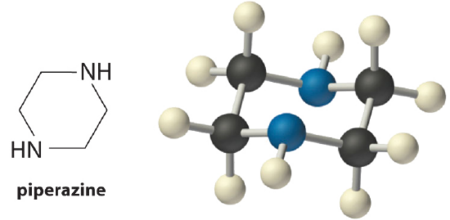
- Answer
-
pH=4.9
Indicators
In practice, most acid–base titrations are not monitored by recording the pH as a part of the amount of the potent acid or base solution used as the titrant. Instead, an acid–base of operations indicator is often used that, if advisedly selected, undergoes a dramatic color alter at the pH respective to the equivalence point of the titration. Indicators are weak acids or bases that showroom intense colors that vary with pH. The conjugate acid and cohabit base of a good indicator have very different colors then that they tin can be distinguished easily. Some indicators are colorless in the cohabit acrid course but intensely colored when deprotonated (phenolphthalein, for example), which makes them particularly useful.
Nosotros tin describe the chemistry of indicators by the following general equation:
\[ \ce{ HIn (aq) <=> H^{+}(aq) + In^{-}(aq)} \nonumber\]
where the protonated form is designated by \(\ce{HIn}\) and the conjugate base by \(\ce{In^{−}}\). The ionization abiding for the deprotonation of indicator \(\ce{HIn}\) is as follows:
\[ K_{In} =\dfrac{ [\ce{H^{+}} ][ \ce{In^{-}}]}{[\ce{HIn}]} \characterization{Eq3}\]
The \(pK_{in}\) (its \(pK_a\)) determines the pH at which the indicator changes color.
Many dissimilar substances can exist used as indicators, depending on the particular reaction to be monitored. For example, red cabbage juice contains a mixture of colored substances that change from deep red at low pH to light blue at intermediate pH to yellow at loftier pH. Similarly, Hydrangea macrophylla flowers tin can be blue, red, pink, light purple, or night purple depending on the soil pH (Figure \(\PageIndex{6}\)). Acidic soils will produce bluish flowers, whereas alkali metal soils will produce pinkish flowers.
Irrespective of the origins, a adept indicator must have the following properties:
- The color change must be easily detected.
- The colour change must be rapid.
- The indicator molecule must not react with the substance being titrated.
- To minimize errors, the indicator should have a \(pK_{in}\) that is within 1 pH unit of the expected pH at the equivalence point of the titration.


Synthetic indicators take been developed that run into these criteria and cover about the entire pH range. Effigy \(\PageIndex{vii}\) shows the judge pH range over which some common indicators modify color and their change in color. In addition, some indicators (such as thymol blue) are polyprotic acids or bases, which change color twice at widely separated pH values.

It is of import to exist aware that an indicator does not alter colour abruptly at a particular pH value; instead, it actually undergoes a pH titration merely like any other acrid or base. As the concentration of HIn decreases and the concentration of In− increases, the color of the solution slowly changes from the characteristic color of HIn to that of In−. Every bit we will see afterwards, the [In−]/[HIn] ratio changes from 0.1 at a pH one unit of measurement below pKin to 10 at a pH i unit above pKin. Thus most indicators change color over a pH range of nearly 2 pH units.
Nosotros accept stated that a skilful indicator should have a pKin value that is close to the expected pH at the equivalence signal. For a strong acid–potent base titration, the selection of the indicator is not particularly disquisitional due to the very large change in pH that occurs around the equivalence betoken. In contrast, using the incorrect indicator for a titration of a weak acrid or a weak base can consequence in relatively large errors, as illustrated in Figure \(\PageIndex{8}\). This effigy shows plots of pH versus volume of base added for the titration of 50.0 mL of a 0.100 Chiliad solution of a strong acid (HCl) and a weak acid (acerb acid) with 0.100 Thousand \(NaOH\). The pH ranges over which two common indicators (methyl red, \(pK_{in} = 5.0\), and phenolphthalein, \(pK_{in} = ix.v\)) change color are also shown. The horizontal confined indicate the pH ranges over which both indicators change colour cross the \(\ce{HCl}\) titration curve, where it is almost vertical. Hence both indicators modify color when essentially the same volume of \(\ce{NaOH}\) has been added (about l mL), which corresponds to the equivalence point. In dissimilarity, the titration of acerb acid volition give very different results depending on whether methyl cherry or phenolphthalein is used every bit the indicator. Although the pH range over which phenolphthalein changes colour is slightly greater than the pH at the equivalence point of the potent acid titration, the error will be negligible due to the slope of this portion of the titration curve. Simply as with the \(\ce{HCl}\) titration, the phenolphthalein indicator will turn pink when well-nigh 50 mL of \(\ce{NaOH}\) has been added to the acerb acid solution. In contrast, methyl cerise begins to change from crimson to yellowish around pH 5, which is near the midpoint of the acetic acrid titration, non the equivalence point. Adding only almost 25–xxx mL of \(\ce{NaOH}\) will therefore cause the methyl ruddy indicator to alter color, resulting in a huge error.

The graph shows the results obtained using two indicators (methyl cherry and phenolphthalein) for the titration of 0.100 Chiliad solutions of a stiff acid (HCl) and a weak acid (acetic acid) with 0.100 M \(NaOH\). Due to the steepness of the titration curve of a potent acrid around the equivalence point, either indicator will chop-chop change color at the equivalence signal for the titration of the strong acrid. In contrast, the pKin for methyl red (5.0) is very shut to the \(pK_a\) of acetic acid (iv.76); the midpoint of the color change for methyl ruddy occurs near the midpoint of the titration, rather than at the equivalence betoken.
In full general, for titrations of strong acids with strong bases (and vice versa), any indicator with a pKin between nearly 4.0 and x.0 will do. For the titration of a weak acid, nevertheless, the pH at the equivalence point is greater than 7.0, and so an indicator such every bit phenolphthalein or thymol blue, with pKin > 7.0, should exist used. Conversely, for the titration of a weak base, where the pH at the equivalence point is less than seven.0, an indicator such as methyl crimson or bromocresol blue, with pKin < 7.0, should be used.
The being of many dissimilar indicators with different colors and pKin values also provides a convenient fashion to estimate the pH of a solution without using an expensive electronic pH meter and a fragile pH electrode. Paper or plastic strips impregnated with combinations of indicators are used as "pH paper," which allows yous to estimate the pH of a solution by simply dipping a piece of pH paper into it and comparing the resulting color with the standards printed on the container (Figure \(\PageIndex{ix}\)).

pH Indicators: https://youtu.be/1IqzUa5lABs
Summary and Takeaway
Plots of acid–base titrations generate titration curves that tin can be used to summate the pH, the pOH, the \(pK_a\), and the \(pK_b\) of the system. The shape of a titration curve, a plot of pH versus the amount of acid or base added, provides of import information most what is occurring in solution during a titration. The shapes of titration curves for weak acids and bases depend dramatically on the identity of the chemical compound. The equivalence point of an acid–base titration is the point at which exactly enough acid or base has been added to react completely with the other component. The equivalence bespeak in the titration of a stiff acid or a potent base of operations occurs at pH 7.0. In titrations of weak acids or weak bases, however, the pH at the equivalence indicate is greater or less than 7.0, respectively. The pH tends to modify more than slowly before the equivalence point is reached in titrations of weak acids and weak bases than in titrations of strong acids and strong bases. The pH at the midpoint, the point halfway on the titration curve to the equivalence point, is equal to the \(pK_a\) of the weak acrid or the \(pK_b\) of the weak base of operations. Thus titration methods tin be used to make up one's mind both the concentration and the \(pK_a\) (or the \(pK_b\)) of a weak acid (or a weak base). Acid–base indicators are compounds that change colour at a particular pH. They are typically weak acids or bases whose changes in color correspond to deprotonation or protonation of the indicator itself.
Source: https://chem.libretexts.org/Bookshelves/General_Chemistry/Map:_Principles_of_Modern_Chemistry_%28Oxtoby_et_al.%29/Unit_4:_Equilibrium_in_Chemical_Reactions/15:_AcidBase_Equilibria/15.6:_Acid-Base_Titration_Curves
0 Response to "Only the First Two Equivalence Points Can Be Observed. What Is the Most Likely Identity of the Acid?"
Post a Comment